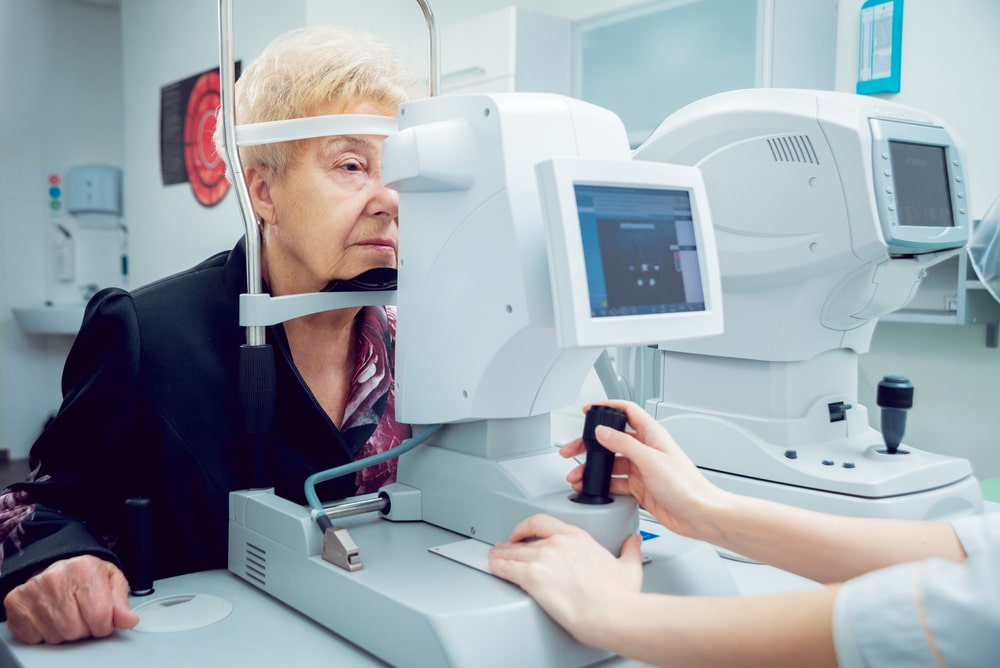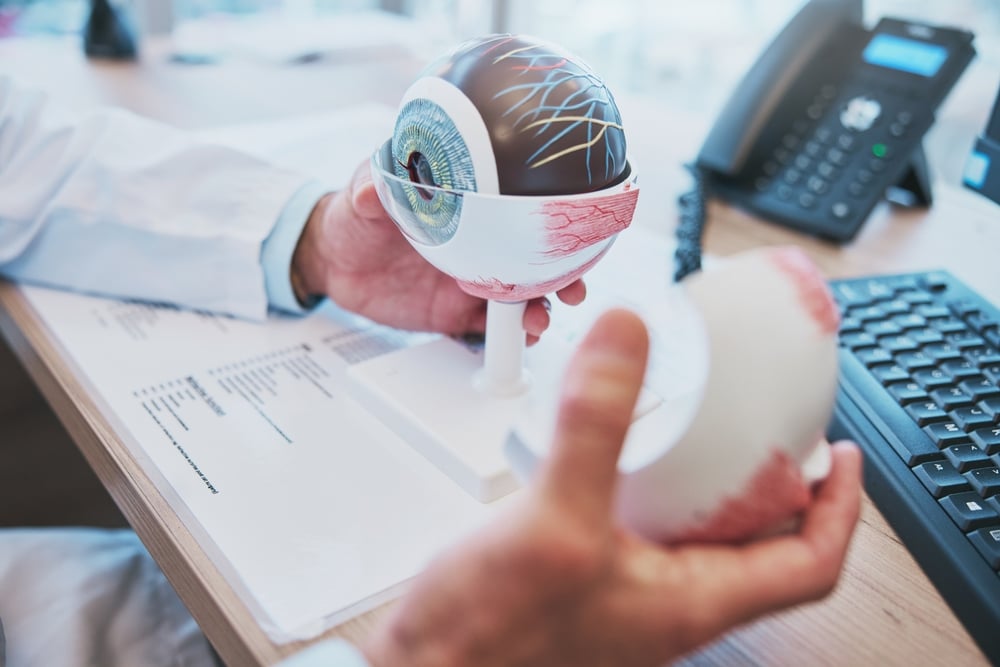If you're experiencing cloudy or blurred vision, difficulty seeing at night, or colors that seem faded, you might be dealing with cataracts. It's not just an inconvenience—it can significantly affect your daily activities and quality of life.
Once a cataract has developed in the lens of your eye, the only treatment is surgery to remove the lens and replace it with an artificial lens. The cataract will continue to progress, eventually leading to blindness in the eye if left untreated. There’s no reason to wait – cataract surgery is one of the safest, most effective surgeries in the world. In the U.S., the success rate with this surgery is over 98 percent.
And there's good news: Our eye doctors are here to help at Shenandoah LASIK & Cataract Center in Winchester, VA.
Our team understands the challenges you face with cataracts and offers laser-assisted cataract surgery as one of our eye services. With our expertise and the latest laser technology, we can restore your vision with precision and care. Get ready to see the world more clearly and regain your independence.
What Is Laser-Assisted Cataract Surgery?
Laser-assisted cataract surgery is a modern approach to treating cataracts. At Shenandoah, we typically offer minimally invasive, small-incision, no-stitch cataract surgery, known as phacoemulsification (phaco). But in laser-assisted surgery, we add the femtosecond laser for greater precision and accuracy. It also means we don’t need to use any surgical blades.

Our team uses this highly precise tool to perform key steps of the surgery. Our doctors use the laser to make the initial incision and to remove the front part of the lens capsule (the anterior capsule). The laser is then used again to create a series of cuts in the cataract-clouded lens. Then, the ultrasound probe is inserted, as with traditional cataract surgery, to finish breaking up and suctioning out the clouded lens before placing the new, crystal-clear intraocular lens.
How Is Laser Cataract Surgery Performed?
The surgery is remarkably fast, requiring only five to 10 minutes. Here are the details of how we do it:
- Getting a Clear Picture: The procedure starts with the femtosecond laser system creating a 3D image of your eye. This detailed image helps the doctor accurately determine where to make the incision.
- Making the Incision: Using the laser, our doctor makes a small incision in the cornea and removes the front part of the lens. This is essential to reach the cataract-clouded lens beneath.
- Precise Cuts: The laser then carefully makes a series of cuts in the clouded lens, preparing it for removal.
- Breaking Up the Lens: Our team will then insert an ultrasound probe, which uses sound waves to break up the cloudy lens into smaller pieces while suctioning them out. Thanks to the earlier laser cuts, less ultrasound energy is needed, making the process gentler on the eye.
- Correcting Astigmatism: If you have astigmatism, our doctor may use the laser to make additional incisions around the cornea to correct this condition. Alternatively, the new intraocular lens (IOL) itself can also correct for astigmatism.
- Inserting the New Lens: The final step involves placing a new, artificial lens inside your eye. These lenses are foldable and inserted through the same small incision to replace the old lens.
- Healing Naturally: The small incision means that you won’t need sutures. It's designed to heal quickly on its own.
Laser-Assisted Cataract Surgery vs. Traditional Cataract Surgery
Laser-assisted and traditional cataract surgery both aim to restore your vision by removing the clouded lens and replacing it with a new intraocular lens (IOL). However, their techniques and tools differ significantly, impacting the surgery's precision, recovery time, and overall patient experience.
Laser-assisted cataract surgery involves:
- Advanced Imaging: The 3D image of the eye allows for precise planning and the most accurate incisions.
- Blade-Free Incisions: The laser is used to make the initial incision in the cornea and open the lens's anterior capsule. This blade-free approach reduces the risk of infection and allows for more predictable and precise incisions.
- Lens Fragmentation: The femtosecond laser then scores the lens, breaking it into smaller pieces. This reduces the need for ultrasound energy traditionally used in phacoemulsification, making the procedure safer and gentler.
- Astigmatism Correction: The laser can also make precise incisions on the peripheral cornea to correct astigmatism during cataract surgery so that you won’t need additional surgical procedures.
- Safe and Fast Recovery: Laser-assisted surgery tends to have a faster recovery time due to the precision of the laser, reduced energy use, and less physical manipulation of the eye.
Traditional cataract surgery involves:
- Manual Techniques: Traditional surgery relies on manual tools to make the corneal incision and to open the lens capsule. These steps are performed using a handheld surgical blade, which requires a high degree of skill and can vary in precision.
- Phacoemulsification: After manual incisions, our doctor uses an ultrasound probe to break up the cloudy lens into pieces. This process typically requires more ultrasound energy than laser-assisted surgery, posing a higher risk of heat-induced damage to surrounding eye structures.
- Limited Astigmatism Correction: Traditional cataract surgery requires a separate procedure or special lenses that correct the vision error without additional cuts.
- Somewhat Less Efficient: While highly effective, traditional surgery generally involves more physical handling of the eye. This can sometimes lead to longer recovery periods and a slightly higher risk of complications.
Overall, laser-assisted cataract surgery is a technologically advanced alternative to traditional methods, providing greater accuracy, potentially better visual outcomes, and a safer surgical environment. It can be particularly beneficial for patients with specific eye conditions or who need highly precise surgical interventions.
Advantages of Laser-Assisted Cataract Surgery

At Shenandoah, our team believes in staying at the forefront of eye surgery technology and believes that the femtosecond laser is a jump forward. Here are some advantages and benefits for our patients to using this laser for cataract surgery:
- Computer guidance provides greater surgical precision.
- All incisions can be made with the laser for a blade-free cataract surgery.
- Laser scoring of the clouded lens before removal reduces the amount of ultrasound energy needed to break up the lens.
- When opening the capsule, the laser creates far less potential for tearing the capsule than when using forceps.
- When breaking up the cataract, the laser creates less heat, which lowers the risk of damaging the incision.
Why Choose Shenandoah Lasik & Cataract Center?
Choosing Shenandoah LASIK & Cataract Center means entrusting your vision to our team.
At Shenandoah LASIK & Cataract Center, patients benefit from the latest technology and comprehensive services, from routine exams to complex surgeries. Our team's commitment to personalized, top-notch care ensures that each patient receives treatment tailored to their needs.
Frequently Asked Questions
Who Is a Good Candidate for Laser-Assisted Cataract Surgery?
If you’re suffering from the increasing cloudiness from a cataract in one or both of your eyes, you’re probably a great candidate for laser-assisted cataract surgery at Shenandoah LASIK & Cataract Center. As mentioned above, there isn’t a cure for a cataract-clouded lens other than removing and replacing the lens.
This is a great procedure to return crystal clear vision if you have these symptoms of cataracts:
- Decreased color vibrancy
- Blurred vision
- Poor night vision
- Increased glare
- Halos surrounding lights
- Double vision
- Frequently changing eyeglass prescription
- A feeling there is a film over the eye
Laser-assisted cataract surgery is remarkably successful, and there are not many contraindications that would prevent you from being able to use the femtosecond laser in your procedure. Our providers will discuss any possible issues with you during your consultation.
Is Preparation for Laser Cataract Surgery Different From Traditional Cataract Surgery?
No. Preparation steps, such as testing your eyes and selecting which intraocular lens you want to replace the cataract with, are the same in both procedures. Otherwise, preparations are quite minimal.
What Is Recovery Like After Laser-assisted Cataract Surgery?
Recovery from laser-assisted cataract surgery at Shenandoah LASIK & Cataract Center is the same as traditional blade surgery.
After your brief surgery, we’ll place an eye patch on your treated eye. We provide you with a protective shield to wear when sleeping for the next several days. Your vision will be blurry at first, but this rapidly improves in a day or two. Your eye may itch somewhat, but you cannot touch the area at all. You also need to avoid actions that increase blood pressure to your face: heavy lifting, bending over, and other actions that move blood to your face. We provide you with eye drops that prevent inflammation and infection. They also control the pressure inside your eye when healing.
Complete healing can take up to two months, but you can return to normal activity in just a few days. You may or may not require glasses for some tasks after your surgery. This depends on the replacement intraocular lens you selected. If your other eye also has a cataract, we usually schedule the second surgery one to two months after the first.
Will I Need Glasses After Having Laser-Assisted Cataract Surgery?
Up until around the turn of the new century, patients having this surgery had only one option for a replacement intraocular lens: monofocal IOLs. As their name implies, monofocal lenses correct for one focal length of vision, either at a distance or up close. Patients would choose which option they wanted, usually choosing distance, and they would wear glasses for the other distance, usually for up close vision such as reading.
Advancements in intraocular lens (IOL) technology have significantly improved the options available for cataract surgery. Today, a variety of multifocal IOLs offer excellent vision at multiple distances. These innovative lenses are particularly effective; they not only correct astigmatism but also address presbyopia, a common condition that affects near vision as we age past 40.
You can explore the premium IOL options available at Shenandoah on our website. Choosing one of these advanced lenses during your cataract surgery might eliminate the need for eyeglasses altogether, regardless of your distance vision needs.
How Much Does Laser-Assisted Cataract Surgery Cost?
The cost of laser-assisted eye surgery can range from about $3,500 to over $6,000 per eye, depending on the technology used, the type of intraocular lens (IOL) implanted, and the facility.
Cataract surgery (including laser-assisted) is typically covered by health insurance as it's considered medically necessary. It still may require some out-of-pocket costs.
Before surgery, we can provide a cost breakdown and help confirm your insurance coverage to avoid unexpected expenses.
Schedule A Consultation
Our team has extensive experience in the laser-assisted cataract surgery, and can offer patients the latest, most advanced treatments to help preserve your vision and your overall quality of life. To learn more about our services, call 540-722-6200 or click here to schedule an appointment in our Winchester, VA office.


